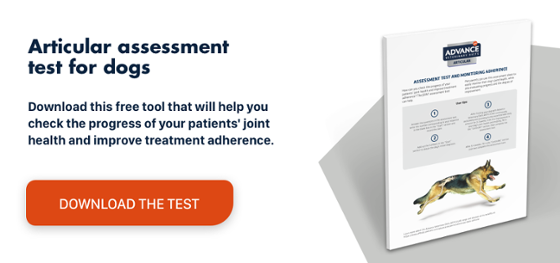Dogs and their joints: how can you determine whether their mobility has improved?
Owners often make the mistake of attributing inactivity and reduced vitality directly to ageing, as they believe that there is no remedy or that any solutions would require surgery. A series of very effective dietary nutrients are available to help protect dogs’ joints, which, as veterinary surgeons, we can recommend to our patients’ owners.
How can we help our clients monitor for improvement in their pets, specifically with respect to the health of their dogs’ joints, and therefore adhere to the treatment?This post contains an easy mobility test that should prove very helpful.
Dogs and their joints: the three most visible symptoms of osteoarthritis in dogs
Joint disease becomes evident when dogs start limping and presenting restricted movement. As it is a slow, progressive condition, owners do not usually pay much attention at first and only visit the veterinary clinic once the animal presents severe difficulty in its everyday activities.
Owners often make the mistake of attributing inactivity and reduced vitality directly to ageing, as they believe that there is no remedy or that any solutions would require surgery. A series of very effective dietary nutrients are available to help protect dogs’ joints, which, as veterinary surgeons, we can recommend to our patients’ owners.9
A test for monitoring joint mobility
To assess the effectiveness of nutritional treatments in dogs and their joints, we suggest using simple owner-reported tests that will allow them to detect any improvements obtained after a few weeks, which would normally be overlooked on a day-to-day basis. They also help the vet monitor the dog’s progress and the outcome of all the veterinary interventions performed on that particular patient. This will highlight which cases require an adjustment to the treatment.
If we manage to involve the client in the assessment, they will usually become more conscious of the disease and take more responsibility for the treatment. This translates into greater treatment adherence.
The following Assessment and Adherence Monitoring Test consists of nine questions about mobility to be answered at three separate moments:
1) before treatment
2) at 2–3 weeks
3) at 4–5 weeks
Which nutrients help protect joints?
There are certain diets and nutritional supplements that not only reduce inflammation and pain, but also play a restorative role in osteoarthritis, while also strengthening the complete joint. Remember that arthritis affects all of the joint, not just the cartilage.
Knowledge of these nutrients and their mode of action can help you recommend an effective diet for the nutritional treatment of degenerative joint problems.
- The combination of chondroitin sulphate, glucosamine and hydrolysed collagen reinforces the cartilage and, along with omega-3 fatty acids, prevents inflammation.
- Hyaluronic acid regenerates synovial fluid formation.
- Vitamin K regulates the calcification of cartilage into bone. It therefore reduces the risk of microfractures and osteoarthritis.
Through the administration of the correct nutrients, the idea of elderly dogs living with healthy joints is perfectly feasible.

